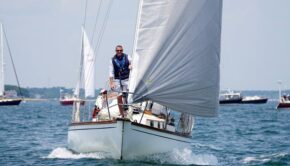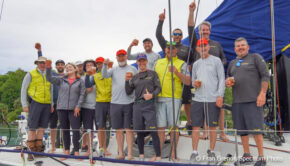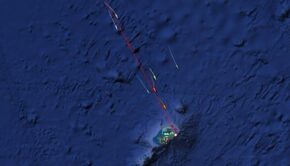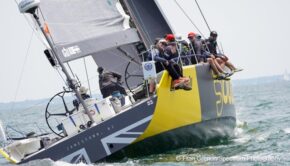Marion Bermuda: Adding to the Adventure
Published on March 19th, 2017
This is the 21st Marion Bermuda Race and the 40th year for the 645-mile open ocean challenge for cruiser type yachts from Massachusetts to the British Territory in the North Atlantic. To add to the adventure, it is also the only US East coast offshore race which features a Celestial Navigation Classification with appropriate time credits.
The Beverly Yacht Club Polaris Trophy is offered for the first celestially navigated yacht and that yacht’s navigator is recognized with the Navigator’s Trophy. In the 2017 Marion Bermuda Race, there are 11 Founders Division racers entered to sail under the Celestial Classification.
These Founders Division yachts, which are 32 to 80 feet and use a cruising sail inventory, will get a 3% credit on their ORR rating handicap time on time. The race starts in Buzzard’s Bay on June 9.
One of those celestial entries, Ray Cullum— a race trustee, past Beverly YC commodore and long-time race volunteer— is sailing his own Bill Dixon designed 44′ sloop Frolic. This is his first time skippering his own boat, but his sixth Marion Bermuda Race in all. He has raced on boats ranging from 39 to 67 feet.
“I did my first MBR in 1999, and we went celestially,” Cullum said. “Going celestially adds an additional level of achievement to the race. You pay a lot more attention to your environment going celestially as your DR [dead reckoning] plot is the all-important method and is something many of us no longer use with the advent of electronic GPS and chart plotters.”
“There is a certain excitement about navigating to an island 650 nautical miles away by the sun, moon and stars,” he added.
Ray has brought a winning navigator on board. Andy Howe, navigator of the 2015 winner Ti will be plotting Frolic’s course south across the Gulf Stream and through the 150 mile long ‘happy valley’ on the approach to Bermuda. Howe has done ten Bermuda races, six from Marion and four from Newport.
“I learned Celestial back in the mid 70’s while doing a stint in the USCG,” noted Howe. “I got better at it running private yachts and delivering them back and forth to the Caribbean. Then for 12 years I worked for Ocean Navigator and taught a lot of navigation courses including celestial. I taught both in classroom sessions and on board their training vessel Ocean Star.
“Celestial is a traditional skill/art. It demands a lot of attention to detail and enough subjective analysis to bring more than number crunching to bear. Being able to take the hard info from sights, the boat dead reckoning information, and then getting it all onto the chart for interpretation is where the art really comes into play.
“The reward from using celestial accurately across 650 miles of open ocean is tremendous. I have rarely been more than 5 miles off in my final position, so it can be done. Doing the 2015 race with a family crew and boat and having all the other variables in the race come together in our favor for multiple wins provided all of us with a lifetime of memories. I hope the Frolic adventure is a repeat of 2015.”
When Frolic reaches a point 50 miles from the finish off Bermuda’s St. David’s Lighthouse, the team can uncover the electronics for the final approach. This is a concession to safety since Bermuda’s northern shore is surrounded by reefs. If you were keeping score it would be something like Reefs 195, Ships and Yachts 0.
During the race, traditional star, sun, planet or moon sights must determine a yacht’s location. Navigators of yachts competing using celestial navigation must at a minimum maintain, and have ready for inspection in Bermuda, a paper-based log of each sight (including body, date, time, and Ha), paper or electronic plotting sheets, and a paper chart showing fixes resulting from sights used for navigation. Most important will be the fix used to determine that the yacht was, or was not, within 50 nm of Kitchen Shoal beacon.
Yachts may use modern onboard non GPS based instruments. Speedometer, distance log, compass, depth sounder and the thermometer use to indicate their location in the warm waters of the Gulf Stream are some of the allowances. Calculators and computers may be used for sight reductions and for computing courses.
Like many of the entries in this year’s race, Ray will be staying for the America’s Cup finals. The America’s Cup Match between the final challenger and Oracle Team USA, the defender will be sailed June 17-27 following the challengers qualifying and playoffs starting May 26.
Race details: http://www.marionbermuda.com
Background: The first Marion-Bermuda Cruising Yacht Race in 1977 saw 104 starters cross the line. Over the forty years since that first race the race has evolved into a true offshore challenge for cruising yachts, amateur, family and youth sailors. Special prizes abound to emphasis celestial navigation, short handed sailing. Family crews and regional competition. The race is handicapped under the ORR rating system to assure the fairest scoring available for ocean racing yachts.
Races within the Race:
• Celestial Navigation— A yacht may elect to race using celestial navigation. If a yacht elects to be celestially navigated, she will receive a 3% favorable adjustment to her ORR rating. This choice must be made by May 12. See NOR Attachment D for the details of the conditions that a yacht must meet to be considered a celestially navigated yacht. In its true Corinthian spirit, the Marion Bermuda Race is the only ocean race to Bermuda that offers a celestial navigation prize.
• The Family Race— A “family” yacht is one with a crew of five (5) or more with all or all-but-one being members of a single household or a single family. Persons related to a common grandparent and spouses of these will be considered “family.”
• The Offshore Youth Challenge— A “youth” yacht is one with at least 4 youths aboard with at least 66% of the crew qualified as youths. A youth sailor must be 16 years of age or older but not more than 23 years old by June 8, 2017. One or more adults at least 23 years old by June 8, 2017 must be onboard.
• The Double-Handed, Short-Handed Competition and All-Female Crew— Yachts sailing with a crew of two (2), a crew of three or four (3 or 4) or an all-female crew may elect to compete in the double-handed, short-handed, and all-female competitions respectively.
• The Team Race Prize is offered for established Yacht Clubs or Sailing Clubs which may form a team of three member yachts to compete for the Team prize. The team whose three yachts have the lowest corrected time total will be declared the winner.
Source: Talbot Wilson










 We’ll keep your information safe.
We’ll keep your information safe.